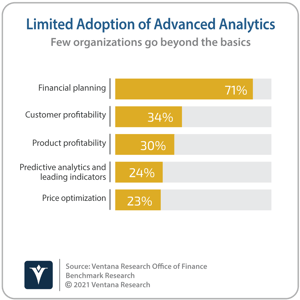Pricing is an issue that almost every for-profit company confronts – and usually agonizes over. Chief financial officers must play a part in setting the strategic direction of pricing in their organization. They should not be involved in tactical pricing decisions because they are not close enough to markets and customers, but they should be part of the strategic design of pricing, especially as part of a profitability management effort, which I’ve discussed before.
 Profitability management is a cross-functional effort that integrates finance and sales to achieve an optimal balance of revenue and margin objectives. This is a more effective data- and analytics-based approach designed to consistently achieve higher sales and fatter margins. Ventana Research asserts that by 2025, one-third of organizations will have implemented a profitability management initiative. One of the pillars of profitability management is strategic pricing.
Profitability management is a cross-functional effort that integrates finance and sales to achieve an optimal balance of revenue and margin objectives. This is a more effective data- and analytics-based approach designed to consistently achieve higher sales and fatter margins. Ventana Research asserts that by 2025, one-third of organizations will have implemented a profitability management initiative. One of the pillars of profitability management is strategic pricing.
CFOs should be strong advocates of a strategic approach to pricing, one that supports profitability management. Strategic pricing decisions are separate from organizational issues such as whether pricing is best handled in a centralized or decentralized fashion. (The answer depends a great deal on the markets the company is serving as well as its organizational structure and culture.) However specific pricing processes are executed, a disciplined approach to price setting and negotiation is always superior to an ad-hoc approach. Discipline is key to preventing margin “leakage” caused by unnecessary price concessions. Configure, price and quote software is a critical component in any leakage-prevention strategy.
A strategic approach to pricing can be the most effective means of optimizing profitability while respecting other objectives (such as market share) and constraints (for example, constrained capacity). While zero-based budgeting and other cost-containment tactics are often used to achieve profit targets, they aren’t the only answer to sustaining profitability. In particular, preventing margin leakage through greater pricing discipline is likely the most effective way for companies to increase the bottom line and prevent profit erosion. In my view, every CFO should take an active role in ensuring that his or her company has effective pricing methods and processes.
 However, our research found that few finance organizations use analytics to gauge profitability: only 34% measure customer profitability, 30% product profitability and just 23% utilize some sort of profit optimization analytics. One specific area where the CFO should be engaged in strategic pricing and profitability management is in understanding how CPQ software can bake in a more consistently disciplined approach to pricing in negotiating sales. CPQ software has been around for decades but has mainly been purchased by the sales and sales operations groups with limited involvement of the CFO. That’s because its original purpose was to quickly configure complex products to speed the sales process.
However, our research found that few finance organizations use analytics to gauge profitability: only 34% measure customer profitability, 30% product profitability and just 23% utilize some sort of profit optimization analytics. One specific area where the CFO should be engaged in strategic pricing and profitability management is in understanding how CPQ software can bake in a more consistently disciplined approach to pricing in negotiating sales. CPQ software has been around for decades but has mainly been purchased by the sales and sales operations groups with limited involvement of the CFO. That’s because its original purpose was to quickly configure complex products to speed the sales process.
The pricing element has only recently increased in importance. Like almost all business issues, improving pricing discipline requires addressing an interrelated set of people, process, information (data) and technology (mainly software) conditions. The people issues center chiefly on roles, responsibilities, communications and compensation. The process issues revolve around establishing successful and repeatable processes for managing pricing – in other words, optimizing who does what and when.
To deal with these people and process issues, some companies have a dedicated pricing organization. In some cases, these groups are tactical in their approach to pricing: managing the creation of price lists, allowable discounts and other necessary elements of implementing pricing and pricing policy. Other pricing departments are more strategic. Their members understand pricing theory and how to apply it to their company’s circumstances and specific pricing processes and systems to better achieve the company’s strategic objectives. As important and complex as the people and process issues can be, my focus here is on some of the software issues, especially as they relate to business-to-business organizations that mainly use a direct-sales model.
A central piece of pricing management software performs configure, price and quote functions. CPQ software, which was first introduced as packaged software in the 1990s, was originally created to simplify and therefore accelerate the process of assembling an accurate price quote for sales involving a complicated set of components. For example, buyers of large commercial trucks can typically choose from multiple engines, cab designs, transmissions and trailer types. Getting a quote back to a buyer quickly can be a competitive advantage since it improves a seller’s odds of securing the contract.
While the configure part of the process is still important, CPQ software is now being used to manage revenue and margins. To minimize margin leakage, it can be used to control the discount from list price offered to the prospect on each component of the sale. The software can also give sales managers and representatives flexibility to apply their judgment to specific situations. For example, reps might be allocated a set amount of pricing discounts during a period and allowed to apply them as they wish.
CPQ software can also be used to ensure that revenue recognition for contracts is always accurate because the accounting treatment for each element of a purchase contract can be accurately and automatically assigned at the time the order is created. This can significantly reduce staff workloads versus doing this work manually and checking that the treatments are accurate.
CPQ software also enables companies to modulate the degree of pricing flexibility according to the product (to move inventory or meet market share goals), region (based on quota attainment in the period to date), customer, or time of month or quarter (to achieve sales volume objectives). CPQ software can provide a built-in incentive to salespeople to maximize profitability by not requiring approvals for sales involving limited discounts. For example, to speed the process and increase their odds of closing a sale sooner, sales representatives will usually offer a 5% discount to customers initially if the sale is pre-approved rather than going for a maximum discount of 10% that must go through a deal desk for an okay.
The configure element can also contribute to margin because, on the other side of the sale, purchasing departments often are evaluated on the discounts they secure in their negotiations. They may therefore be highly sensitive to the pricing and discount offered on the core item of an order but less sensitive to shipping and handling costs or the price of complementary goods or services that are part of a contract bundle. Some CPQ software prompts salespeople to recommend highly profitable complementary products and services to the buyer to increase the size of the transaction and boost margins.
While controlling costs to achieve margin and profitability objectives is a traditional responsibility of the CFO, that alone is no longer enough. He or she must step up to a leadership role, supporting more effective pricing strategies and practices. Leadership by the CFO is necessary because of the change-management aspects of adopting a new approach to pricing and because of the impact that a new approach to pricing can have on the company’s profitability and financial position.
For their part, finance departments should be more involved in pricing and profitability analytics. At the very least, they should be able to provide analyses of the impacts of variances in volume and pricing on results – especially in identifying the sources of margin leakage and its impact.
Regards,
Robert Kugel

 Profitability management is a cross-functional effort that integrates finance and sales to achieve an optimal balance of revenue and margin objectives. This is a more effective data- and analytics-based approach designed to consistently achieve higher sales and fatter margins. Ventana Research asserts that by 2025, one-third of organizations will have implemented a profitability management initiative. One of the pillars of profitability management is strategic pricing.
Profitability management is a cross-functional effort that integrates finance and sales to achieve an optimal balance of revenue and margin objectives. This is a more effective data- and analytics-based approach designed to consistently achieve higher sales and fatter margins. Ventana Research asserts that by 2025, one-third of organizations will have implemented a profitability management initiative. One of the pillars of profitability management is strategic pricing. However, our research found that few finance organizations use analytics to gauge profitability: only 34% measure customer profitability, 30% product profitability and just 23% utilize some sort of profit optimization analytics. One specific area where the CFO should be engaged in strategic pricing and profitability management is in understanding how CPQ software can bake in a more consistently disciplined approach to pricing in negotiating sales. CPQ software has been around for decades but has mainly been purchased by the sales and sales operations groups with limited involvement of the CFO. That’s because its original purpose was to quickly configure complex products to speed the sales process.
However, our research found that few finance organizations use analytics to gauge profitability: only 34% measure customer profitability, 30% product profitability and just 23% utilize some sort of profit optimization analytics. One specific area where the CFO should be engaged in strategic pricing and profitability management is in understanding how CPQ software can bake in a more consistently disciplined approach to pricing in negotiating sales. CPQ software has been around for decades but has mainly been purchased by the sales and sales operations groups with limited involvement of the CFO. That’s because its original purpose was to quickly configure complex products to speed the sales process.








